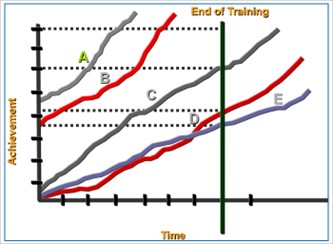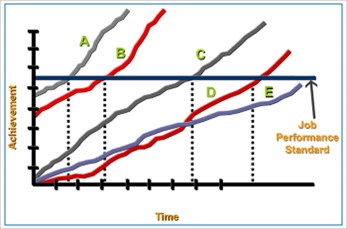Why is Competency-Based Training So Effective?
Jill W.
There is a wide variety of training methods that can be used at the workplace. Because eLearning is often content-based, we often forget about competency-based training, which is delivered as blended learning or as facilitated on-the-job training. Training a forklift driver is a good example of this approach. The trainee can learn safety rules, load specifications and the location of the controls from manuals or an eLearning course. But to demonstrate the competency, "Operate Forklift", the trainee has to physically get in and drive the forklift and operate it to specific standards.
In this article, I'll explain what competency-based training is, why it is effective and the benefits of competency-based training.
Competency-based training - a question of Yes or No
Teaching a learner to be able to perform a skill or task to a predetermined standard is the essence of competency-based training. At the end of the training, the key question is "Can the learner perform to the expected standard: Yes or No?".
Competency-based training is driven by these core principles:
- Focus on outcomes - what matters most is that the job is done to a degree that meets or exceeds an expected standard
- Greater workplace relevance - stronger focus on practical skills
- Outcomes as observable competencies - observing that a task has been done to meet or exceed a predetermined standard
- Use of assessments to judge competence - Less focus on testing and more focus on whether a worker can or can't perform a task to an expected standard in the work environment
- Improvement of skills - more emphasis on improving skills performance rather than on just improving knowledge about the skills or task
Let's dig a little deeper into what competency-based training means.
Competency-based training vs. traditional training

Traditional instruction follows a fixed time/variable performance model. Students enter the learning event with different levels of skills and abilities. They then engage in the learning event for a fixed period of time, after which they are evaluated. The emphasis here is on completing training within a fixed time limit.
This model works well when we want to identify the differences in individuals and, with that understanding, direct them into different occupational roles.

In a competency-based model, a standard is set and multiple types of support are provided to ensure that those able to meet the pre-set standard. Here, the emphasis is on achieving competency at one's own pace.
It comes down to a basic question of, "Can the learner do the task to the expected job performance standard?'
A "Yes" answer means the learner is competent. A "No" answer means that he or she is not.
So, what's the process?

There are a number of ways to approach competency-based training. I prefer this seven-step process, which uses a blended delivery approach to deliver the knowledge portion of the training through eLearning and/or classroom instruction and delivers the practical portion through physical demonstration, practice and skill evaluation.
Let's take a closer look at each of these steps:
- Access learning resources - Learners are given the learning requirements for their specific job and the learning resources for self-study. These resources may be paper-based, online or available as facilitated classroom sessions and may include technical descriptions, standard operation procedures, eLearning, etc.
- Complete self-study and self-tests - Learners are encouraged to use the learning resources to help them meet the learning objectives and prepare for the knowledge evaluation. Self-tests consisting of questions randomly selected from a question bank are completed to confirm learners' understanding of learning points. Questions that are incorrectly answered are reviewed to increase each learner's understanding of the topic.
- Complete knowledge evaluation - A final test is completed to confirm the learners' mastery of the knowledge portion of the skill.
- Participate in a practice demonstration - Learners observe a designated coach performing a practical demonstration of the skill. This demonstration is completed using the target performance standard, along with any relevant learning resources. The demonstration is repeated until the learner confirms that they understand how the skill is performed.
- Practice with supervision - Practice is required to develop learners' ability to perform the skill to the pre-set standard and reinforce best practices on the job. Learners are encouraged to get feedback and input from coaches and peers as they practice.
- Complete practical evaluation - When learners are satisfied that they have mastered the skill, they request an evaluation. The knowledge portion of the evaluation includes a review of the important knowledge requirements, especially hazards and precautions. The practical portion of the evaluation is conducted by a competent team member or supervisor who directly references a skill checklist and performance standards.
- Update learning records - After learners have successfully demonstrated mastery of the skill to the pre-determined standard, their records are updated in the LMS to indicate that competency for that skill has been achieved.
Why is competency-based training so effective?
Competency-based training measures the learning that occurs in a training program rather than the time it takes to learn. In other words, learners move through training based on their skills and competencies, regardless of the time needed to complete the course. In many cases, especially with experienced employees, traditional classroom training is less effective in terms of performance because of the time it takes to complete the training. In competency-based training, the learning outcome is the constant while the time needed to complete the training is allowed to vary to meet learner-specific requirements.
As well, competency-based training:
- Shifts the focus of the training from the trainer to the trainee - classroom training runs on the trainer's schedule and at the trainer's pace. For many trainees, that pace is either too slow or too quick. Rather than teaching and lecturing in a traditional manner, in competency-based training the trainer becomes a mentor or a coach and guides the learner as they try the skill and learn from their successes and failures. Many adult learners prefer this approach rather than listening to sage advice from the head of the class.
- Aligns assessments and evaluations with competencies - learners are assessed and evaluated against performance objectives and standards. When assessment results are low, or an evaluation is not successfully completed, practical exercises can be created to beef up the areas of skill that are lacking. The learner is told and is shown what to do, how to do it and to what standard the task must be done. This gives the learner concrete goals that, when achieved, can be taken to work and demonstrated at the workplace.
Employer benefits of competency-based training
So far, I've talked about how the learner benefits from competency-based training. But what's in it for the employer?
Well, anything that makes workers happy with the training they receive and improves their skills has to benefit the employer. Competency-based training also:
- Increases productivity - Well trained, happy and motivated workers are more productive than those who are not. When people know what the expectations of them are and have been trained to meet or exceed those expectations, they have a greater degree of job satisfaction and take a greater interest in the success of their firm.
- Lowers training costs - Because the training focuses on specific goals (acquiring new skills or improving existing ones), there is less time and money spent on training employees on things at which they are already competent. In addition, because the expected outcome of competency-based training is performance improvement, costs due to poor performance are reduced.
- Standardizes performance within the company - Having pre-determined standards for all tasks done by all personnel helps to ensure consistency and quality in production and in product.
- Records employee skill acquisitions and competencies - This makes it easier for employers to pinpoint areas where training is needed. It also helps in making decisions around promotions, specialized training and cross-training.
- Lowers the time taken to transfer skills to the job - In a competency-based system, training and assessment are relevant to what needs to be done on the job. This means that it takes less time for employees to become competent in required skills, which, in turn, contributes to improved training and assessment efficiency.
Conclusion
In this article, I've described what competency-based learning is. I explained a seven-step model that can be used to implement a competency-based training program. I gave a few examples of why competency-based training is effective and finished by listing some examples of how this type of training benefits the employer.
Competency-based training is effective in occupations where theoretical knowledge and practical, hands-on application meet. The theory (or knowledge piece) is delivered online, through self-study, in class or a combination of any of the three. The practical application is demonstrated by a coach, facilitator, instructor, or mentor and then practiced by learners until they feel ready for their skills to be evaluated. When the answer to the question "Can the learner perform the task to the expected standard?" is "Yes", the training has been successful.
Competency-based training has been used for a long time and will continue to be an essential training method across industries. It has evolved to incorporate eLearning and will continue to evolve to include new methods of content delivery, but the practical demonstration and evaluation of skills learned will remain the same.
Free eBook
Optimizing Competency-Based Learning
Learn how competency-based learning could benefit your organization!
TopicsChoose Topic
📘 Ready to Elevate Your Learning Strategy?
Explore our comprehensive library of eBooks and tools on learning resource development, competency-based learning, and LMS implementation. Transform your training programs with insights from industry experts and practical templates.
Jill W.
Jill is an Instructional Designer at BaseCorp Learning Systems with more than 10 years of experience researching, writing and designing effective learning materials. She is fascinated by the English language and enjoys the challenge of adapting her work for different audiences. After work, Jill continues to leverage her professional experience as she works toward the development of a training program for her cats. So far, success has not been apparent.

